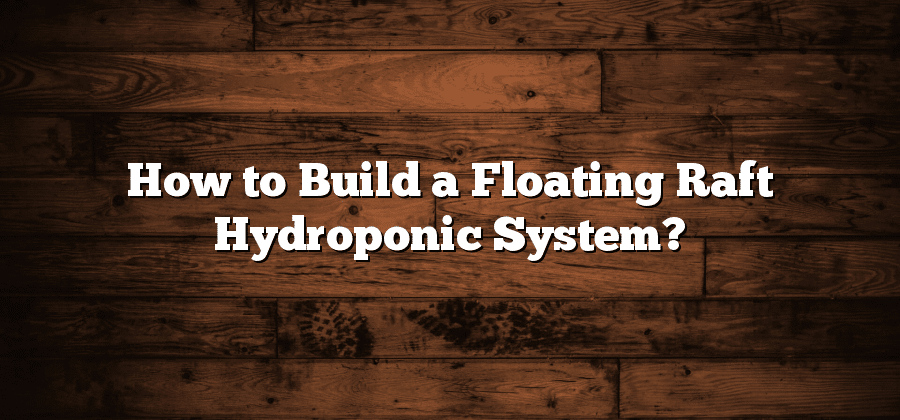Understanding the Basics of Hydroponics
Hydroponics is a modern method of growing plants without the use of soil. Instead, plants are grown in a nutrient-rich water solution, allowing for optimal growth and development. This technique has gained popularity in recent years due to its numerous benefits, including increased yield, faster growth rate, and the ability to grow plants in limited spaces.
One of the key advantages of hydroponics is the control it provides over the growing environment. Essential nutrients are directly delivered to the plants, ensuring that they receive exactly what they need for healthy growth. In addition, water and pH levels can be carefully regulated, creating an ideal environment for plant growth. This level of control allows for higher yields and healthier plants, making hydroponics a preferred choice for many farmers and gardeners.
Choosing the Right Materials for a Floating Raft Hydroponic System
When it comes to designing and building your floating raft hydroponic system, selecting the appropriate materials is crucial for its success. The choice of materials will determine the durability, functionality, and overall performance of your system. Therefore, it is essential to do thorough research and make informed decisions.
One of the key materials you will need for your floating raft hydroponic system is the floating raft itself. This is the platform on which your plants will be placed, allowing their roots to reach the nutrient-rich water below. The floating raft should be made of a sturdy and non-toxic material that can withstand the weight of the plants, as well as the constant exposure to water and sunlight. Many hydroponic gardeners prefer to use food-grade polystyrene foam boards, as they are lightweight, buoyant, and resistant to water damage. Alternatively, you can also opt for PVC foam boards or even rigid plastic sheets, depending on your budget and availability.
Another important material to consider is the trough or container that will hold the nutrient solution. This should be made of a thick, durable, and waterproof material that can withstand the corrosive effects of the nutrient solution and resist leakage. Common options include high-density polyethylene (HDPE) troughs, which are chemical-resistant and long-lasting, or fiberglass containers, which are lightweight and have excellent water resistance properties. Remember to choose materials that are safe for growing food, as the health and quality of your plants are paramount.
In conclusion, choosing the right materials for your floating raft hydroponic system is essential for its effectiveness and longevity. Consider factors such as durability, functionality, and safety when selecting materials like the floating raft and the trough. By making informed decisions and investing in high-quality materials, you can create a sustainable and productive hydroponic system that will yield impressive results.
Designing the Layout of Your Floating Raft Hydroponic System
An important aspect of designing a layout for your floating raft hydroponic system is to carefully plan the spacing between the raft beds. Proper spacing allows for optimal growth and development of plants while ensuring efficient use of space. Consider the specific needs of your plants, such as their growth habits, size, and spacing requirements. This will help you determine the ideal arrangement for your floating raft system.
Another factor to consider when designing the layout is the positioning of the water pumps and aeration system. These components are vital for providing the necessary nutrients and oxygen to the plants. Proper placement of the pumps and aeration devices ensures uniform distribution of water and nutrients throughout the system. Additionally, having a well-designed layout will also help facilitate easy access to the pumps for maintenance and adjustments. Overall, careful planning and consideration of these aspects during the design phase will contribute to the success of your floating raft hydroponic system.
Building the Frame and Structure of the Raft
When it comes to building the frame and structure of your floating raft hydroponic system, there are a few key considerations to keep in mind. Firstly, it is important to choose materials that are durable and water-resistant, as they will need to withstand constant exposure to moisture. Opting for materials such as PVC pipes or treated lumber can help ensure the longevity of your system.
Next, you will need to decide on the size and shape of your raft. This will depend on the space available and the number of plants you wish to grow. A common approach is to create a rectangular frame using the chosen materials, securing them together with screws or adhesives. Additionally, reinforcing the corners with brackets or metal connectors can provide added stability to the structure. Once the frame is securely assembled, you can proceed to the next steps of installing the floating rafts and planting beds, which will be covered in the following sections of this article.
Installing the Floating Rafts and Planting Beds
Once the frame and structure of the raft system are in place, the next step in the installation process is to add the floating rafts and planting beds. This step is crucial in creating the optimal growing environment for your hydroponic plants.
To begin, carefully place the floating rafts on top of the water-filled frame, ensuring that they are evenly spaced and aligned. The rafts should be large enough to accommodate the size and number of planting beds needed for your specific crop. Once the rafts are in position, it is time to install the planting beds. These can be made of various materials, such as plastic or foam, and should be designed to allow for proper drainage and aeration. Carefully place the planting beds onto the floating rafts, ensuring that they are securely attached and will not shift or move during the growth process. This will provide stability and support for your plants as they take root and begin to grow.






